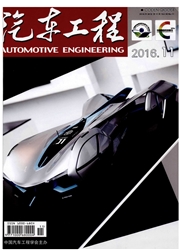

 中文摘要:
中文摘要:
在一台排放达到国Ⅲ标准的直列四缸进气道喷射汽油机上,分别燃用汽油、M15、M50甲醇汽油3种燃油,采用欧洲测试循环中的城市道路工况和高速公路工况循环,对3种燃料的燃烧特性、醇醛排放和燃油经济性进行了测试。结果表明:最大爆发压力随着掺醇量的增加而增大,且出现的曲轴转角位置提前。掺醇汽油的最大放热率比纯汽油的高,主燃期缩短,循环变动率降低。未燃甲醇和甲醛排放随掺醇比例的增大而增加,随负荷的增大先增加后降低,经催化转化器催化后排放几乎为零。 M15和M50的当量燃油消耗率在中高负荷下比汽油低,特别在高速大负荷条件下最大降幅达9.0%。
 英文摘要:
英文摘要:
The combustion characteristics, the emissions of methanol and formaldehyde, and the fuel economy are tested of an in-line 4-cylinder port-injection gasoline engine, meeting State-III emission standard, fueled with gasoline, M15 and M50 methanol/gasoline blends respectively with urban road and highway cycles of European test cycles. The results show that with the increase in methanol content, the peak cylinder pressure rises with an earlier relevant crank angle. Compared with pure gasoline, the methanol/gasoline blend has a higher peak heat release rate, a shorter main combustion period and a low cycle variation rate. The emissions of unburnt methanol and formaldehyde rise with the increase in methanol proportion, and they go up first and then fall down when the load increase and almost become null after catalyzed by TWC. The equivalent specific fuel consumption of blend fuels is lower than that of gasoline at medium and high load with its maximum reduction amplitude reaching 9 % at high speed high load condition.
 同期刊论文项目
同期刊论文项目
 同项目期刊论文
同项目期刊论文
 Experimental investigation on regulated and unregulated emissions of a diesel/methanol compound comb
Experimental investigation on regulated and unregulated emissions of a diesel/methanol compound comb Experimental and Computational Studies on Ignition Characteristics of Diesel in a Premixed Ethanol-A
Experimental and Computational Studies on Ignition Characteristics of Diesel in a Premixed Ethanol-A Simulations of diesel-methanol dual-fuel engine combustion with large eddy simulation and Reynolds-a
Simulations of diesel-methanol dual-fuel engine combustion with large eddy simulation and Reynolds-a Experimental and modelling studies of the effects of methanol and ethanol addition on the laminar pr
Experimental and modelling studies of the effects of methanol and ethanol addition on the laminar pr Experimental and modeling study of the effect of ethanol and MTBE on the oxidation of PRF90 in low p
Experimental and modeling study of the effect of ethanol and MTBE on the oxidation of PRF90 in low p 期刊信息
期刊信息
